Exmoor Beach Beast
Posted by: Loren Coleman on January 9th, 2009
Something washed up ashore on a Croyde Bay beach, near Exmoor, UK. The British tabloids are having a field day trying to link it to the Beast of Exmoor. But, of course, it is not an Alien Big Cat or even a Mystery Cat. It is some form of marine mammal, for it has remnants of flippers, and well, it is a beach, right?
The ABC was blamed, but the seal’s been named, baby. Where’s the beast?
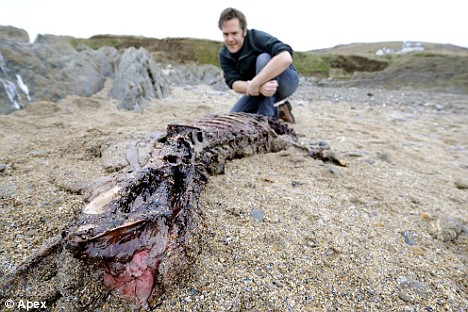
The Daily Mail reported on January 9th, that it is five feet long, with a
…powerful chest, and what could be the remains of a tail.
A carcass of an animal that has washed up on a beach in North Devon has left many of the locals speculating that it is the body of the infamous Beast of Exmoor.
Had it been washed up on any other shore, it might simply have been dismissed as the unfortunate remains of a large dog.But this was North Devon. And folk in these parts have learned that sightings of mystery animals are likely to mean only one thing – the Beast of Exmoor is back.
***
‘It’s only about five miles away to Exmoor by sea, it could easily have floated down.’
PC Tucker added: ‘It’s a good 5ft and it has black fur. It certainly looks quite beast-like with those teeth.’
***
Samples sent for analysis revealed that the Beast of Croyde Bay was simply a grey seal.
Decomposition meant its flippers had vanished to reveal bones that looked like they might have been limbs.
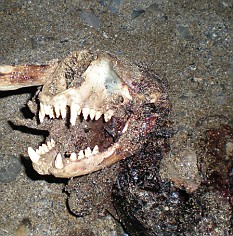
The Exmoor Beach Beast skull.
As compared to…
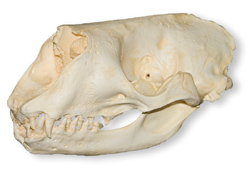
Halichoerus grypus Grey Seal (northern Atlantic and southern Arctic oceans)
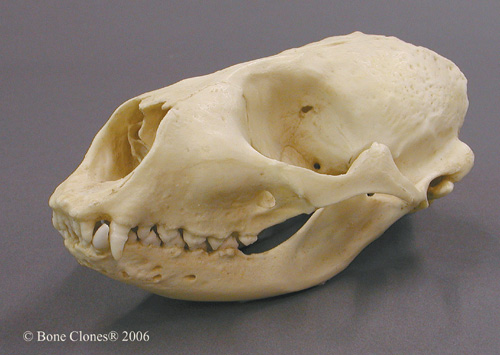
Phoca vitulina Harbor Seal (coastal areas of the Atlantic and Pacific oceans)
Now for something completely different…
< 
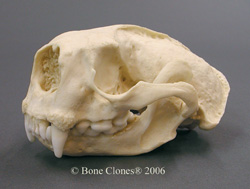
Enhydra lutris Sea Otter (West Coast, North America)
Meanwhile, early this morning, the Centre for Fortean Zoology sent out a press release:
Two nights ago a carcass was washed up on Croyde Beach in North Devon. The Centre for Fortean Zoology, [CFZ], were informed, and they sent a three-man team of investigators – Graham Inglis (52), deputy director, Oll Lewis (28), ecologist, and Matthew Osborne (28), one time Bideford town councillor, trainee Methodist lay preacher, and all round good egg – to find out what the fuss was about. The CFZ are the world’s largest mystery animal research organisation, and they happen to be based less than 30 miles from where the mysterious carcass was washed up.
Various newspapers and media pundits have claimed that what was washed up was the cadaver of the beast of Exmoor – the notorious big black cat which for decades has been selling newspapers and killing sheep with equal abandon. From the photographs we had been e-mailed, it was pretty obvious that this was nonsense, that the CFZ would not be doing their job properly if they just took a cursory look at the photograph on their computers, before dismissing the matter from their minds.
The body was about 5 ft long, and – according to the team – reeked to high heaven. It was obviously a member of the seal family, and is almost certainly the remains of an unfortunate grey seal (Halichoerus grypus), which is a fairly common resident of the wilder parts of the Bristol Channel. However, there is an outside possibility that it could be something more exciting. One of the experts who first viewed of the photographs suggested that it looked like the skull of a sealion. There are seven species in the world, but with the exception of one species found on the coast of Argentina, all sealions are restricted to the Pacific Ocean. However, in the 1980s a Steller’s sealion turned up on the Brisons – two tiny islets, a mile out to sea from the west coast of Cornwall. No one knew how it got there, and – as far as we know – it may still be there today.
Experts will be examining the skull and other samples over the next few days, and will hopefully have a conclusive answer. So, although it certainly isn’t anything to do with the beast of Exmoor, it might just be only the second sealion ever to grace these shores.
Please note, according to the Daily Mail, this morning, “Samples sent for analysis revealed that the Beast of Croyde Bay was simply a grey seal.”
That would be Halichoerus grypus, a grey seal.
~~~Updated clarification: It appears that only the CFZ has had this material for safe keeping and identification purposes (despite silly claims the skull was “stolen” according to late media accounts). It is getting to be all so circular, and further new info will be forthcoming.
Finally, see Darren Naish, here.
About Loren Coleman
Loren Coleman is one of the world’s leading cryptozoologists, some say “the” leading living cryptozoologist. Certainly, he is acknowledged as the current living American researcher and writer who has most popularized cryptozoology in the late 20th and early 21st centuries.
Starting his fieldwork and investigations in 1960, after traveling and trekking extensively in pursuit of cryptozoological mysteries, Coleman began writing to share his experiences in 1969. An honorary member of Ivan T. Sanderson’s Society for the Investigation of the Unexplained in the 1970s, Coleman has been bestowed with similar honorary memberships of the North Idaho College Cryptozoology Club in 1983, and in subsequent years, that of the British Columbia Scientific Cryptozoology Club, CryptoSafari International, and other international organizations. He was also a Life Member and Benefactor of the International Society of Cryptozoology (now-defunct).
Loren Coleman’s daily blog, as a member of the Cryptomundo Team, served as an ongoing avenue of communication for the ever-growing body of cryptozoo news from 2005 through 2013. He returned as an infrequent contributor beginning Halloween week of 2015.
Coleman is the founder in 2003, and current director of the International Cryptozoology Museum in Portland, Maine.










Before the furor really hit the press, Matin Cotterill, Big Cats in Britain taxidermist and natural history collector, identified this as a seal
The British papers recently have been running photographs, some hoaxes which we have readily identified and listed the source; but they still continue to publish these mon-events.
The recent stories of Forestry Commission workers photographing big cats is also false. They observed them through night vision equipment, (twice in the last seven years)they could not see the colour of the animals, and only described them as slighly larger then normal cats. One discrepency here is, Shaun Stevens of BCIB conducted an FOI of every British police force and council, including the Forestry Commission The FC came back saying they had no records, now they are saying that they have.
Sometimes, there is no mystery, however much others (media) want their to be
well the skull doesn’t look liek that seal really. the teeth are too long. 🙂
We shall watch with interest what the official testing comes up with, and well done to the CFZ for collecting the skull, just exactly what should have been done.
The media need to stop making assumptions about things, and making it seem as though its something “mysterious”, throwing away any reasonable explanations and getting the craziest story they can sell without becoming a tabloid
They always get everything wrong
The fact is that it is almost certainly going to turn out to be a grey seal. However, the fact that we did what we did, means that researchers in ten years time will not come across a faded press cutting, and jump to erroneous conclusions. There is no substitute for fieldwork.
Could not agree with Jon more. What Jon and his mates did is comparative to the fieldwork done here, for
example, in 2006, which shifted the Maine Mutant carcass hysteria from literally a field here to two DNA labs, and a mystery solved.
Cryptozoologists around the world are responsible for moving the media madnesses to scientific realities.
Maybe I should give a quick note, just to allay any fears that anyone may have of us here in the UK believing the media. The collection of hard evidence is a priority. In the last year alone British big cat researchers have been on endless ‘goose chases’ for bodies.
We often have these reported, but what you do not hear about is the efforts of the researchers finding them. We have chased black bin liners on the side of roads, tyres that people have reported as a large black cats, teddy bears placed strategically, and recently one researcher risked life and limb to video a greyhound in the middle of a busy motorway that the witnesses were adamant was a puma. We have a body report at least once a month.
Researchers, ordinary people, across the British Isles spend a lot of time and effort chasing these things up, solving the case before the press get hold of it, and turn it into another non-event. But we usually do not publish these things.
The CFZ did exactly what they should have done, based near the beach, they retrieved the skull and specimens, brilliant. Although the press have done the damage now, and big cats roaming the British countryside will be regulated to the ranks of nuts and crack pots again, because of this. The CFZ have the evidence, and it should be noted that I am not aware of one British big cat researcher claiming that this was a big cat, only the media did this. I was actually cut off by a couple of reporters because I would not state that this was even possibly a big cat; so we were never heard, our opinions were not wanted, simply because they wanted it to be something it was not.
Researchers, cryptozoologists across the world do a lot of hard work that is never heard about; damn the bloody media
Mark Fraser Big Cats in Britain
It’s amazing in this day and age when – as Loren proves – a decent amount of clear, illustrated references is a few mouseclicks away, that anyone could think this was a “monster”. It’s not like the beast is hiding or at a distance – it’s right there, dead! It’s goofball hysteria like this that makes cryptozoology look bad.
Not really, because no-one even remotely involved with cryptozoology ever suggested that the carcass was of anything but a pinniped. Even the policemen who first discovered it claimed that they thought it was a seal of some kind. The furorw about it being a mystery cat was purely a media invention.
For as long as we have a mass media that exists purely in order to entertain the lowest common denominator in society and sell them overpriced nonsense, with no hint of journalistic ethics this is going to be what happens.
Not quite sure how you make out it makes look cryptozoology look bad, I repeat not one British researcher said this was a big cat. This was the media trying to sell newspapers regardless of the truth! Or am I missing something here 🙂
that i would have to say looks like a seals skull but i might be wrong. But i honestly think it is a seal’s skull.
those are not the same skulls their different animal skull’s . one of them looks like a seal’s skull ,and the other i have never seen a creature that has that kind of bone structer.
one skull is made for chewing vegitation and ther other is made for eating meat so they are not the same creature.
@ Scotcats
I should have specified, in the eyes of the general public. I didn’t mean that it would make actual researchers look bad.
The CFZ has solved the case, and so please go here, to find all the appropriate links and elementary info.